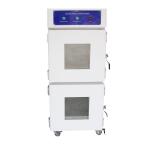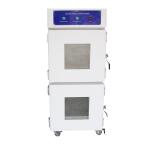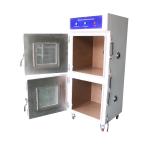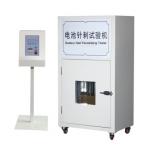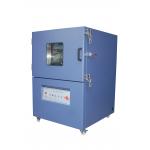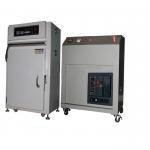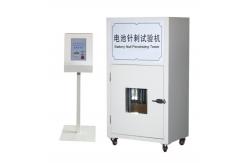In the automotive industry's rapid shift towards electrification,
the reliability and safety of automotive batteries have become the
cornerstone of success. The Battery Inner Short Circuit Testing
Machine, specifically designed for automotive battery testing,
emerges as a crucial innovation in safeguarding the integrity of
these power sources. This state-of-the-art testing machine is dedicated to detecting and
analyzing internal short circuits within automotive batteries. It
serves automotive manufacturers, battery suppliers, research
institutions, and regulatory bodies. The core objective is to
anticipate and mitigate potential safety hazards that could arise
from internal short circuits, such as thermal runaway, which could
have catastrophic consequences in a vehicle. By subjecting
automotive batteries to comprehensive inner short circuit tests,
stakeholders can optimize battery designs, enhance manufacturing
processes, and ensure compliance with the stringent safety
standards of the automotive sector. - Automotive-Grade Robustness and Precision
- The machine is constructed with a heavy-duty framework, crafted
from high-strength automotive alloys, to withstand the rigors of
testing large and powerful automotive batteries. The testing
chamber is engineered with meticulous precision, featuring a
non-conductive and heat-resistant interior lining made of advanced
composites. This lining not only shields the machine's components
from the intense heat and chemical byproducts of a short circuit
but also ensures accurate and consistent test results. The door of
the chamber is designed for an airtight and secure seal,
incorporating a redundant locking mechanism and a
high-temperature-resistant gasket. It also includes a large,
optically clear viewing window, made of toughened and
anti-reflective glass, allowing for detailed visual inspection of
the battery during testing.
- Advanced Detection and Monitoring Systems for Automotive Batteries
- Electrical Parameter Analysis: Equipped with ultra-precision
voltage and current sensors, the machine can detect the slightest
fluctuations in the battery's electrical characteristics. These
sensors have a wide dynamic range, capable of handling the high
voltages and currents typical of automotive battery systems. The
resolution is fine-tuned to identify minuscule changes that could
signal the onset of an internal short circuit. The data acquisition
system records and analyzes these electrical parameters in
real-time, generating detailed graphs and reports that pinpoint the
exact moment and location of a potential short circuit.
- Temperature Surveillance: To comprehensively assess the thermal
behavior of automotive batteries during testing, the machine is
outfitted with a network of temperature sensors. These sensors can
measure a broad temperature spectrum, from sub-zero temperatures to
over 1200°C, with an accuracy of ±0.5°C. They are strategically
placed both on the surface and within the interior of the battery,
providing a 3D understanding of the heat distribution. The
temperature data is crucial in determining whether a short circuit
is leading to a dangerous temperature rise and potential thermal
runaway, allowing for timely intervention.
- Gas Detection and Analysis: In the event of an internal short
circuit, automotive batteries may release various gases, some of
which could be toxic or flammable. The testing machine includes
highly sensitive gas sensors that can detect and identify a wide
range of gases, such as hydrogen, carbon monoxide, and volatile
organic compounds. The sensitivity of these sensors is adjustable,
enabling the detection of even trace amounts of gases. This feature
not only helps in assessing the safety of the battery but also
provides valuable insights into the chemical reactions occurring
within the battery during a short circuit, aiding in the
development of more stable battery chemistries.
- Controlled Stimulation and Stress Application for Automotive
Scenarios
- The machine is capable of replicating a variety of real-world
stressors that automotive batteries may encounter. It can apply
mechanical vibrations similar to those experienced during vehicle
operation, with the vibration frequency and amplitude precisely
adjustable. The frequency can range from a few hertz to several
thousand hertz, and the amplitude from a fraction of a millimeter
to several millimeters, allowing for the simulation of different
driving conditions. Additionally, it can subject the battery to
rapid temperature changes, mimicking the thermal stresses of
extreme climates or high-power charging and discharging cycles. The
rate of temperature change can be adjusted, typically from a few
degrees Celsius per minute to hundreds of degrees Celsius per
minute. It can also apply electrical pulses or overcharge
conditions in a controlled manner, simulating abnormal operating
scenarios that could lead to internal short circuits, such as a
faulty charging system or a sudden power surge.
- Intuitive Control and Data Management Interface for Automotive
Testing
- The control panel of the testing machine is designed with
automotive engineers and technicians in mind. It features a
user-friendly touchscreen interface that allows for easy setup of
test parameters, such as the type and intensity of stress to be
applied, the duration of the test, and the sampling rate for data
acquisition. The interface also provides real-time feedback on the
test progress, displaying the current values of electrical
parameters, temperature, and gas concentrations. The data
management system is highly efficient, automatically storing all
test data in a secure and organized manner. The data can be easily
retrieved, sorted, and analyzed
|
